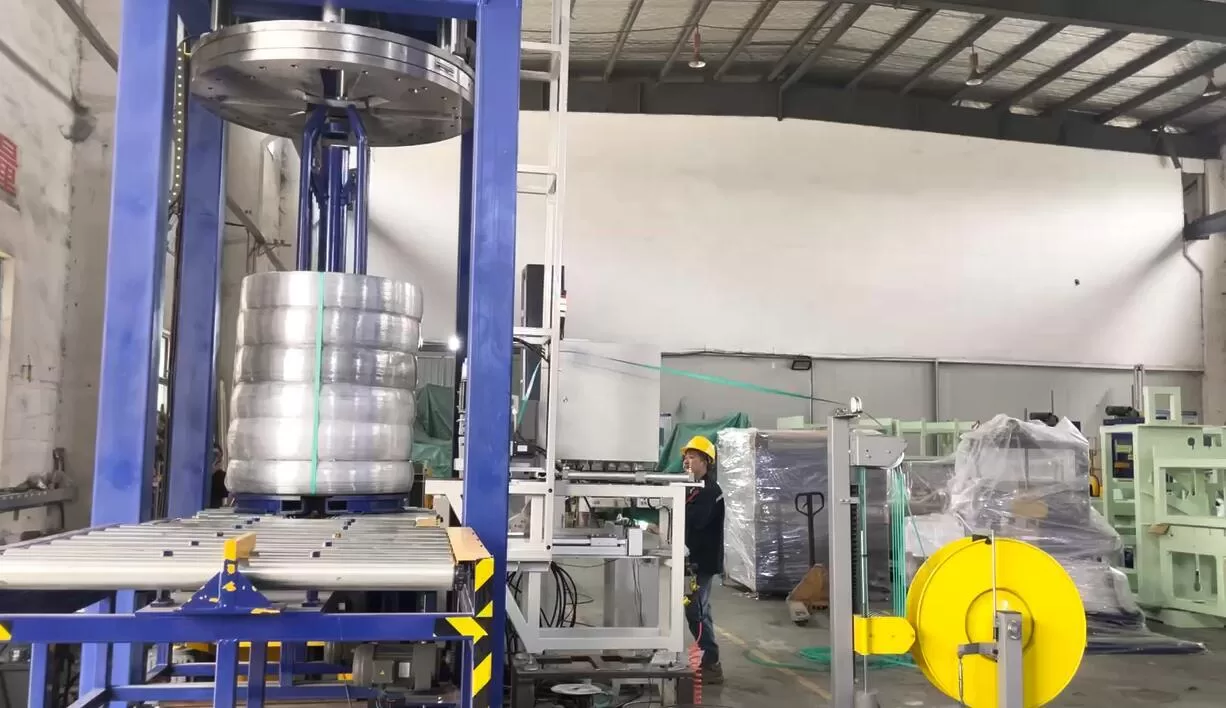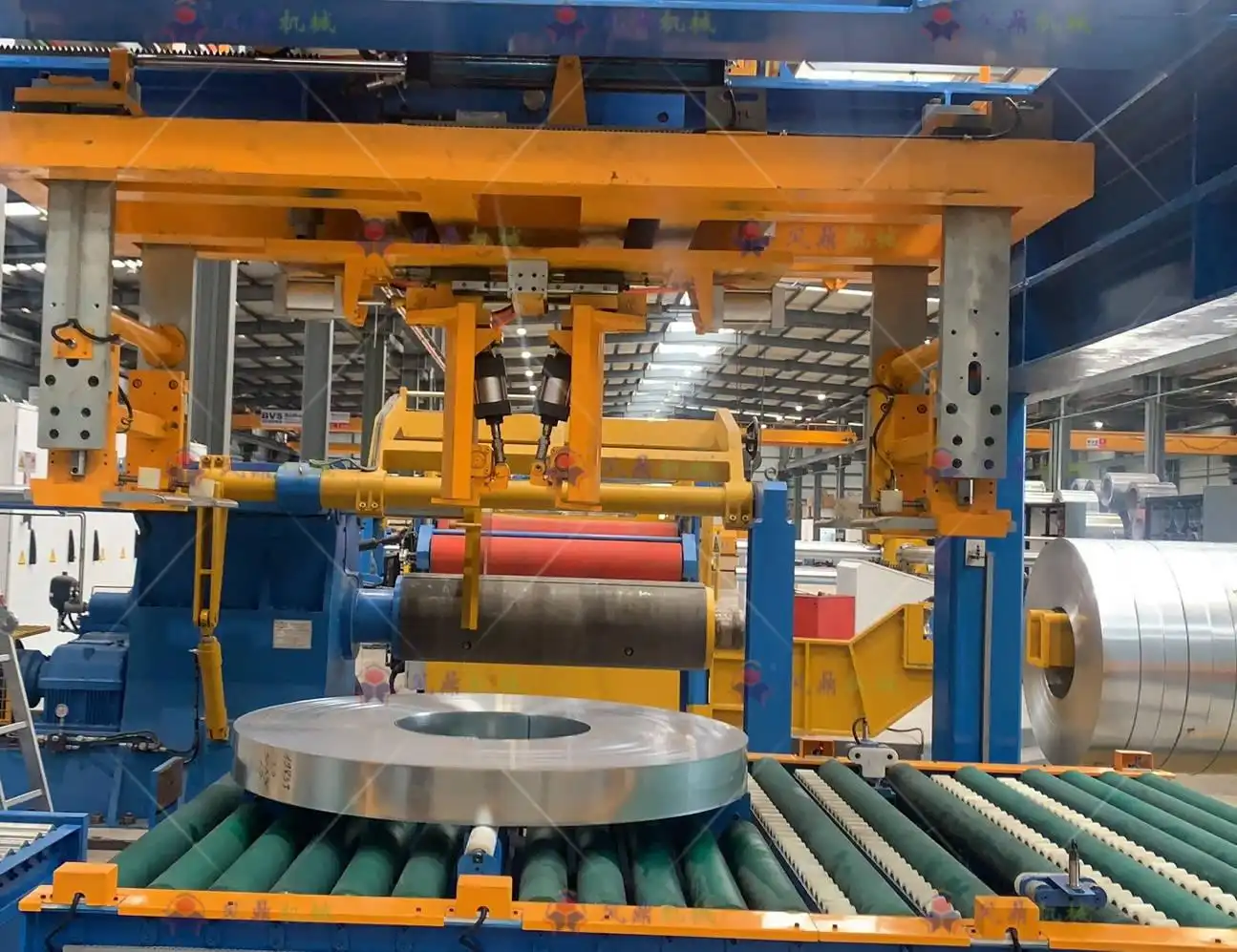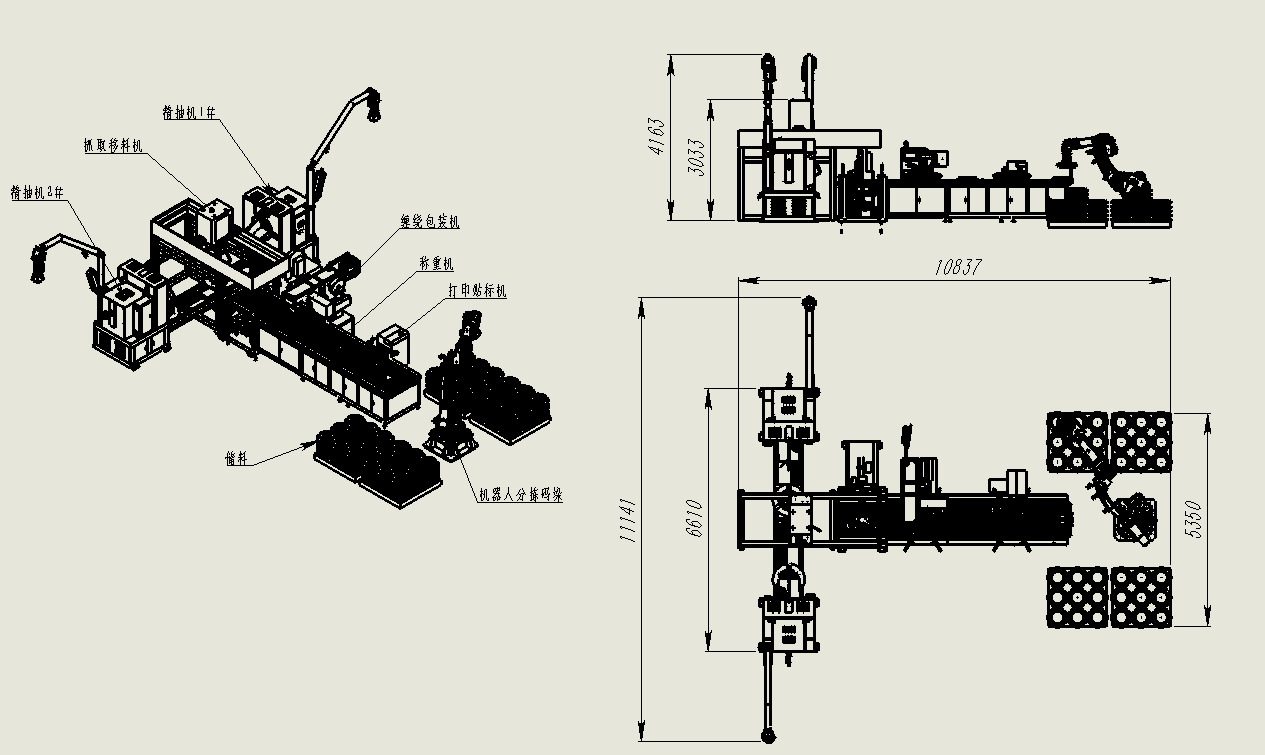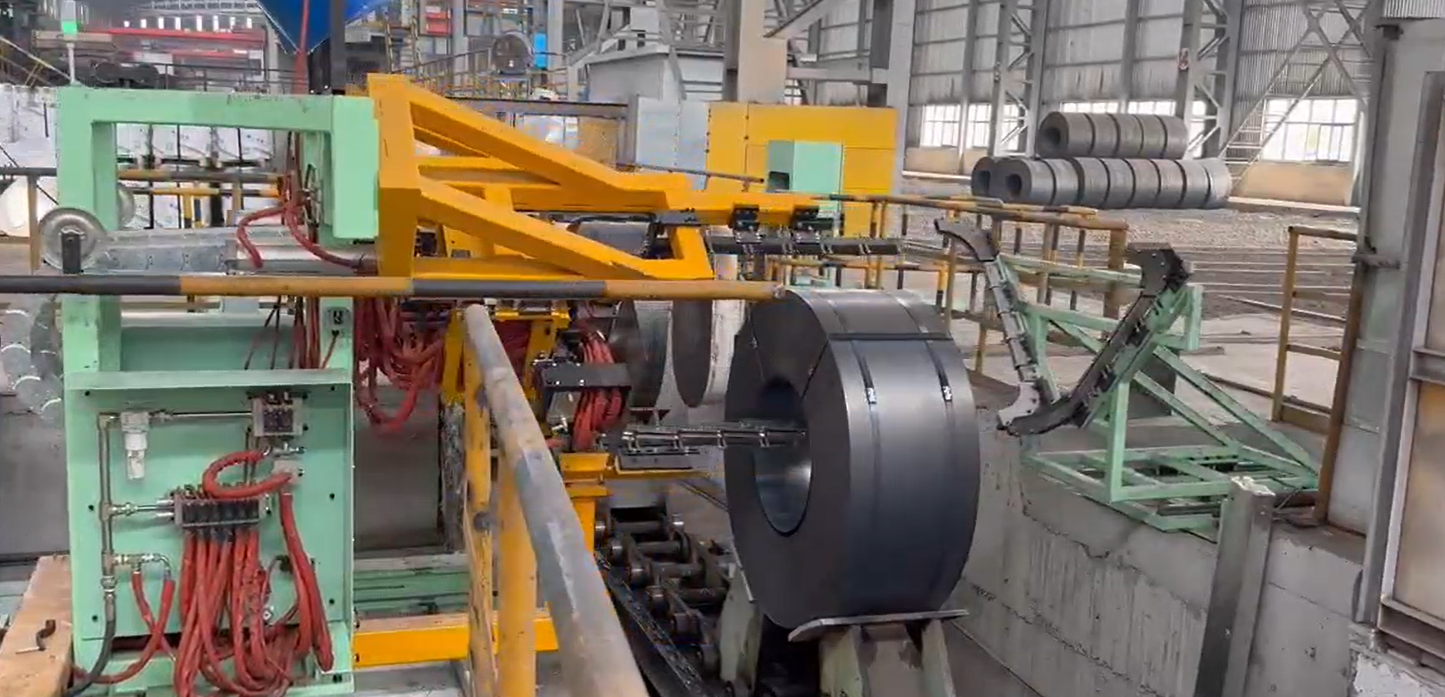Operating a steel mill in a harsh environment like Saudi Arabia brings unique challenges. The extreme heat can cook sensitive electronics. Abrasive dust and sand can grind down moving parts. Any equipment downtime in this setting is not just an inconvenience; it is incredibly costly. You worry about production targets while your team battles the elements just to keep things running.
Imagine your packing line failing in the middle of a high-volume production run. Steel coils begin to pile up. Your shipment schedules are thrown into chaos. Your technical team is scrambling in the sweltering heat, trying to diagnose and fix a machine that was clearly not built for this reality. This is a constant fear for plant managers and owners in demanding climates. It’s a scenario that undermines efficiency, morale, and profitability. But what if there was a packing line specifically engineered to thrive in these conditions? A system so reliable that technical teams in Saudi Arabia don't just use it—they trust it completely.
Saudi technical teams trust this steel coil packing line because its design directly confronts the challenges of a harsh environment. It is built with oversized mechanical components, industrial air conditioning for sealed electrical cabinets, and dust-proof enclosures for all moving parts. These core features ensure consistent, reliable performance and minimal need for maintenance, even in the extreme heat and abrasive dust common to Saudi steel facilities. It's not just a machine; it's a solution engineered for survival and efficiency.

This level of trust isn't given easily. It is earned through performance, day after day, in some of the toughest industrial settings on the planet. As an engineer who has spent my entire career designing and building these systems, I want to break down exactly what makes this equipment so resilient. Let's look at the specific engineering choices that separate a standard machine from one that can handle the pressure. My goal is to share the knowledge I’ve gained so you can see why this approach is the right choice for any high-stakes steel operation, whether it's in Saudi Arabia, Mexico, or anywhere else that demands reliability.
How does a robust design conquer Saudi Arabia's extreme heat and dust?
When you invest in capital equipment, you expect it to work. But standard machinery often fails quickly in extreme environments like those found in Saudi Arabia. The intense, dry heat can warp frames and cause electronics to overheat. Fine, abrasive dust gets into everything, destroying bearings, jamming sensors, and causing premature wear on critical components. You end up paying for a machine that simply cannot handle the reality of your operations.
This leads to a frustrating cycle of failure and repair. Every breakdown means lost production, delayed shipments, and mounting maintenance costs. Your technical team, who should be focused on optimizing output, instead spends their valuable time fixing the same problems over and over. You start to question the machine's lifespan and wonder if you made the right investment. It’s a constant source of stress for any plant owner.
A truly robust design, however, anticipates these problems from the very beginning. It isn't about simply making things bigger; it's about making them smarter. A robust packing line is built with materials, components, and protective features specifically chosen to fight back against heat and dust. This proactive approach to engineering is what ensures the machine works reliably, day in and day out, no matter how harsh the conditions.
A robust design conquers extreme heat and dust by using a multi-layered defense strategy. It starts with heavy-duty, reinforced steel frames that resist thermal warping. It continues with fully sealed, IP65-rated electrical cabinets equipped with dedicated industrial air conditioning units to keep sensitive electronics cool and clean. Finally, all moving parts, like conveyor rollers and wrapping ring gears, are protected by sealed bearings and durable bellows to prevent abrasive dust from causing wear and failure.

Deeper Dive: Engineering for Survival
To truly understand how a design achieves this level of durability, we need to look closer at the specific engineering decisions. It's a combination of material science, thermal management, and mechanical protection.
Component Selection for Durability
The foundation of a robust machine is the quality of its components. In a standard environment, you might get away with using common, off-the-shelf parts. In a harsh environment, that's a recipe for disaster. We consciously select components that are rated for higher temperatures and tougher conditions. For example, we use motors with a higher insulation class (Class H) that can operate reliably at higher ambient temperatures. The PLC and VFDs are chosen from product lines specifically designed for industrial extremes. Even the wiring is specified with high-temperature-resistant jacketing. It costs more upfront, but it prevents catastrophic failures down the line.
Sealing and Protection Against Contaminants
Dust is the silent killer of machinery. It's abrasive and conductive. To combat this, we take a "seal and protect" approach. Every electrical cabinet is a fortress. We use NEMA 4/IP65 rated enclosures, which are designed to be dust-tight and water-resistant. The doors have knife-edge seals and multi-point latches to ensure a perfect seal every time. For moving parts, we go beyond simple guards. We use sealed-for-life bearings that require no re-greasing, eliminating a potential entry point for dust. For linear guides and power transmission screws, we install durable fabric or metal bellows that expand and contract with the movement, completely shielding the sensitive surfaces from the outside world.
Thermal Management Strategies
Heat is the other major enemy. Electronics generate their own heat, and when the ambient temperature is already 45°C (113°F), you need an active cooling strategy. Passive vents are not enough; in fact, they would just let in more dust. This is why every single one of our main control cabinets for these environments includes a closed-loop industrial air conditioner. This unit maintains a stable internal temperature (around 25°C/77°F) regardless of the outside heat, dramatically extending the life of PLCs, drives, and power supplies. It's a non-negotiable feature for reliability in places like Saudi Arabia.
| Feature | Standard Machine | Harsh Environment Machine (SHJLPACK) | Benefit |
|---|---|---|---|
| Frame | Standard structural steel | Reinforced, stress-relieved steel | Resists thermal warping, maintains alignment |
| Motor Rating | Class F Insulation | Class H Insulation, TEFC design | Higher temperature tolerance, dust-proof |
| Control Cabinet | Vented, fan-cooled | NEMA 4/IP65 Sealed with A/C | Protects electronics from heat and dust |
| Bearings | Open or shielded | Sealed-for-life | Prevents dust contamination, zero maintenance |
| Sensors | Standard photoelectric | IP67-rated, with air purge fittings | Reliable operation in dusty conditions |
This level of detail is what creates trust. When a technical team sees that a machine was designed with their specific problems in mind, they know they have a reliable tool, not another problem to solve.
What customizations make this packing line a perfect fit for high-volume steel mills?
A one-size-fits-all packing line can severely limit the potential of a high-volume steel mill. An off-the-shelf system, designed for average throughput, quickly becomes a bottleneck when faced with the output of a modern, 2-million-ton-per-year facility. The conveyors might be too slow, the strapping cycle might take too long, or the machine might not be able to handle the full range of your coil sizes. This mismatch forces you to slow down your entire production line just to let the packing station catch up.
You end up with a system that creates more problems than it solves. Coils queue up, waiting to be packed. Your logistics team is under pressure because shipment schedules are at risk. It feels like you have invested in a major piece of equipment that is actively working against your primary goal of maximizing output. You are forced to adapt your process to the machine's limitations, instead of having a machine that adapts to your needs.
The solution is a packing line that is not just sold, but co-designed. It must be customized from the ground up to match your specific needs: your required throughput in coils per hour, your exact range of coil widths and diameters, and your existing factory layout and workflow. When you achieve this level of integration, your packing station is transformed from a frustrating bottleneck into a powerful competitive advantage that supports your mill's maximum capacity.
Key customizations for high-volume mills include modular, high-speed conveyors capable of intelligent queuing, dual strapping and wrapping stations that work in parallel to slash cycle times, and fully automated systems for weighing, labeling, and data logging. These customizations ensure that the packing process is perfectly synchronized with the speed of your production line, eliminating bottlenecks and allowing your mill to operate at its full potential.

Deeper Dive: Tailoring the Solution
Customization is a collaborative process. It starts with us understanding your goals. Are you trying to pack 60 coils per hour or 90? What is the heaviest and widest coil you produce? Where does the data from the packing line need to go? The answers to these questions shape the final design.
Matching Throughput: More Than Just Speed
Increasing throughput isn't just about making the wrapper spin faster. It's about optimizing the entire sequence. For high-volume mills, we often propose a parallel processing layout. While one coil is being wrapped, the next coil is already being positioned, weighed, and strapped. This eliminates waiting time. We use intelligent conveyors with zone control. The system knows where every coil is and can buffer them or speed them up to ensure a continuous flow into the packing stations. We also design high-speed strapping heads that can apply four straps in the time a standard machine applies two. It's about analyzing every second of the cycle time and finding ways to reduce it.
Handling a Wide Range of Coil Specifications
A steel mill might produce narrow slit coils for one customer and wide master coils for another. The packing line must handle this variability without lengthy changeover procedures. Our designs incorporate automated adjustments. The conveyor side guides, the centering mechanism, and the strapping lance position can all be adjusted automatically based on the coil recipe selected in the HMI. An operator can switch from packing a 500mm wide coil to a 1500mm wide coil with the press of a button. This flexibility is critical for a mill that serves diverse markets.
Integration with Upstream and Downstream Systems
A modern packing line does not operate in isolation. It is a node in your factory's digital ecosystem. This is a key area of customization for forward-thinking owners like Javier. We ensure our control system can communicate seamlessly with your plant's MES (Manufacturing Execution System). The packing line can receive coil ID and specifications from the MES as a coil arrives. After packing, it sends back a complete data package: final weight, number of straps applied, wrapping material consumed, and a timestamp. This data is vital for quality control, inventory management, and achieving the kind of total production visibility that is at the heart of Industry 4.0.
| Customization Option | Standard Feature | High-Volume Customization | Benefit for a 2M Ton/Year Mill |
|---|---|---|---|
| Layout | Single, in-line process | Parallel stations for strapping/wrapping | Doubles packing capacity, eliminates bottlenecks |
| Conveyors | Fixed speed, basic rollers | Variable speed, intelligent zone control | Smooth, continuous flow; prevents coil collision |
| Coil Sizing | Manual adjustment for width | Fully automated guide and center adjustment | Zero changeover time, maximum flexibility |
| Data Integration | Standalone HMI | Level 2 MES/ERP integration | Full production visibility, automated data logging |
This tailored approach ensures that the investment is not just in a piece of hardware, but in a solution that grows with your business and directly supports your most important operational goals.
How does integrated automation reduce downtime and labor costs in demanding environments?
In a demanding environment like a steel mill, relying heavily on manual labor for packing is both inefficient and risky. People get tired, especially in extreme heat, and fatigue leads to mistakes. This results in inconsistent wrap quality, damaged products, and potential safety incidents. Furthermore, finding and retaining skilled workers for repetitive, physically demanding jobs is a constant challenge. High employee turnover means you are always training new people, which further impacts consistency and efficiency.
You find yourself constantly battling issues that are directly tied to manual processes. One operator wraps coils tightly, another wraps them loosely. This inconsistency can lead to customer complaints. Downtime increases when an operator makes a mistake, needs a break, or is simply not available for a shift. Every one of these issues directly hits your bottom line by reducing output and increasing operational costs. It's a system that is inherently unreliable and difficult to scale.
Integrated automation is the definitive solution to these challenges. A fully automated packing line performs the same task perfectly, every single time, 24 hours a day, 7 days a week. It removes workers from potentially hazardous areas, improving plant safety. By automating repetitive tasks, it allows you to reassign your valuable team members to more complex, value-added roles like quality control and system supervision. It delivers predictable, repeatable results that you can count on.
Integrated automation reduces downtime and labor costs by creating a seamless, operator-independent process. It uses a network of sensors, PLCs, and robotic systems to manage everything from coil entry and centering to strapping, wrapping, weighing, and labeling. This minimizes human error, drastically increases throughput, and allows a small, highly-skilled team to oversee the entire operation from the safety of an air-conditioned control room. The result is lower labor costs, higher safety, and predictable, maximized uptime.

Deeper Dive: The Mechanics of Automation
Automation is more than just replacing a person with a robot. It's about creating an intelligent, self-regulating system. This is central to achieving the goals of digitalization and cost reduction that owners like Javier prioritize.
The Role of PLC and HMI in Centralized Control
The "brain" of the entire automated line is the Programmable Logic Controller (PLC). We use powerful, industry-standard PLCs from brands like Siemens or Allen-Bradley. The PLC receives input from hundreds of sensors across the line—photoelectric sensors that detect a coil's position, encoders that measure conveyor speed, and load cells that determine weight. Based on its programming, it makes decisions in milliseconds, sending commands to motors, pneumatic valves, and strapping heads. The Human-Machine Interface (HMI) is the window into this brain. It's a graphical touchscreen that allows a supervisor to select recipes, monitor the status of the entire line, and diagnose any issues. A single, well-trained operator can manage the entire packing process from this one central point.
From Manual to "Lights-Out" Packing
A fully automated line handles the entire workflow. A coil arrives on the entry conveyor. Sensors detect its presence and dimensions. The PLC directs the conveyor to move it to a centering station. Once centered, it moves to the strapping machine, where a robotic arm applies the straps precisely. Then it proceeds to the wrapping station, where it is wrapped according to the pre-defined recipe. Finally, it moves to an automated weigh-and-label station before exiting to the warehouse. No hands touch the coil during this entire process. This "lights-out" approach is the ultimate goal for efficiency and safety.
Safety and Cost Benefits of Automation
The most immediate benefit is removing people from the "danger zone" around heavy, moving equipment. Light curtains and safety fences create a protective perimeter, and the PLC will immediately shut down the line if that perimeter is breached. This drastically reduces the risk of accidents. The cost benefits are just as significant. A fully automated line can often be run by one supervisor per shift, compared to three or four manual laborers. The payback on the investment, when factoring in reduced labor costs, increased throughput, and elimination of quality-related rework, is often less than 24 months.
| Task | Manual Packing Line | Automated Packing Line (SHJLPACK) | Benefit |
|---|---|---|---|
| Labor Required | 3-4 operators per shift | 1 supervisor per shift | >60% reduction in labor costs |
| Cycle Time | Variable, operator-dependent | Consistent, optimized by PLC | Predictable, maximized throughput |
| Quality | Inconsistent wrap/strap tension | Perfectly repeatable per recipe | Zero defects, higher customer satisfaction |
| Safety | High risk of strain/crush injuries | Operators outside safety perimeter | Drastic reduction in safety incidents |
| Data Collection | Manual logs, prone to error | Automatic logging to MES/database | 100% accurate data for analytics |
For a data-driven leader like Javier, these metrics are not just numbers. They represent a clear path to achieving his goals of lower operating costs, higher efficiency, and a safer, more modern factory.
Why is comprehensive support more valuable than the machine itself?
Buying a complex piece of industrial equipment like a packing line is just the first step. The purchase itself is a transaction. But what happens next determines the true value of your investment. Without proper support, the installation process can be a nightmare of delays and unexpected costs. If training is inadequate, your team will struggle to operate the machine efficiently and safely. And when you inevitably need a spare part, waiting weeks for it to arrive from an overseas supplier can bring your entire production line to a grinding halt.
This is a scenario I have seen too many times. A factory owner invests millions in a new machine, only to be left on their own to figure out complex integration challenges. When a critical sensor fails or a drive faults, they are stuck. Their expensive, high-tech asset is sitting idle, costing them money every hour it isn't running. This is the exact opposite of the strategic partnership that a forward-thinking business leader needs. It turns a potential asset into a liability.
A true partner, on the other hand, understands that their job begins, not ends, with the sale. They provide comprehensive, end-to-end support throughout the entire lifecycle of the machine. They collaborate with you on the initial design. They have engineers on-site to supervise the installation and commissioning. They provide in-depth training for both operators and maintenance staff. And they guarantee fast, reliable access to technical support and spare parts. This holistic approach is what ensures your machine delivers maximum value and ROI from day one and for many years to come.
Comprehensive support is more valuable than the machine itself because it is the ultimate guarantee of performance, uptime, and long-term ROI. This support transforms the purchase from a simple transaction into a strategic partnership. It includes collaborative design consultations, on-site installation and commissioning supervision, multi-level training for your team, and a proactive lifecycle management plan with readily available spare parts. This ensures your investment is always protected and always productive.

Deeper Dive: A Partnership in Three Phases
Viewing support as a continuous relationship is key. I've built my company, SHJLPACK, around this philosophy. We structure our partnership approach in three distinct but connected phases.
Phase 1: Collaborative Design and Pre-Installation Planning
This phase begins long before any metal is cut. My team and I work directly with your engineers and project managers. We study your factory layout, your product flow, and your strategic goals. We create detailed 3D models and layout drawings to show exactly how the new line will fit into your existing space. We discuss utility requirements—power, compressed air, data connections—to ensure there are no surprises during installation. This is the stage where we build trust and align our solution with your vision. I remember a project for a client in a humid, coastal region. During this phase, we identified that their standard compressed air had high moisture content. We added a dedicated industrial air dryer for the packing line's pneumatic system into the design. This small change prevented months of future problems with sticking valves and corrosion.
Phase 2: On-Site Installation and Commissioning
We don't just ship you a machine in a crate and a manual. We send our own experienced engineers to your facility. They work alongside your local contractors to supervise the mechanical and electrical installation, ensuring everything is done correctly and to specification. Once assembled, our engineers power up the system and begin the commissioning process. They meticulously test every single function, every sensor, every motor, and every safety feature. This culminates in a Site Acceptance Test (SAT), where we demonstrate that the machine meets all the agreed-upon performance criteria before we hand over the keys.
Phase 3: Lifecycle Management and Proactive Support
Our partnership continues long after your line is running. We provide in-depth training tailored to different roles—one program for daily operators, and a more technical one for your maintenance team. We provide a comprehensive list of recommended spare parts and offer kits that you can keep on-site to minimize downtime. And through modern remote access technology, our engineers can securely log into your machine's PLC from our office to help diagnose problems in real-time, often solving an issue in minutes instead of days. This is what it means to be a strategic partner. We are invested in your success.
| Support Level | Standard Supplier | Strategic Partner (SHJLPACK) | Value to the Owner |
|---|---|---|---|
| Design | Offers standard models | Collaborative co-design process | Solution is perfectly tailored to your needs |
| Installation | Provides manuals & phone support | On-site engineering supervision & commissioning | Faster, error-free startup; guaranteed performance |
| Training | Basic operator manual | Multi-level training for operators & maintenance | Empowers your team, reduces user error |
| After-Sales | Reactive; parts ordered on failure | Proactive; remote diagnostics & spare parts kits | Maximizes uptime, minimizes production loss |
When you choose a supplier, you are choosing a partner. Their commitment to your long-term success is the single most important factor in realizing the full value of your investment.
Conclusion
In harsh conditions, success hinges on robust engineering, smart automation, and a partner you can trust. This packing line delivers on all three, ensuring reliability and profitability for years.
A Final Word from Vincent
I started my career as an engineer on a factory floor. I know the feeling of a production line stopping because a single machine failed. Later, when I built my own factory, I learned the pressures of being an owner. I had to worry about production targets, employee safety, and making payroll. That journey taught me a valuable lesson: when you invest in equipment, you are not just buying steel and motors. You are buying a promise. A promise of reliability, of efficiency, and of support.
That is why I founded SHJLPACK. My mission is not just to sell machines. It is to share the knowledge I have gained and to be the partner I always wished I had. For a leader like Javier, I know the decision to invest in a new line is about more than just numbers on a spreadsheet. It is an investment in your factory’s future, your team’s well-being, and your company’s competitive edge.
My commitment is to ensure that investment pays dividends. We build machines that work, especially when conditions are tough. We stand behind them with support that you can count on. Because your success is our success. That is the total solution we promise to deliver.





